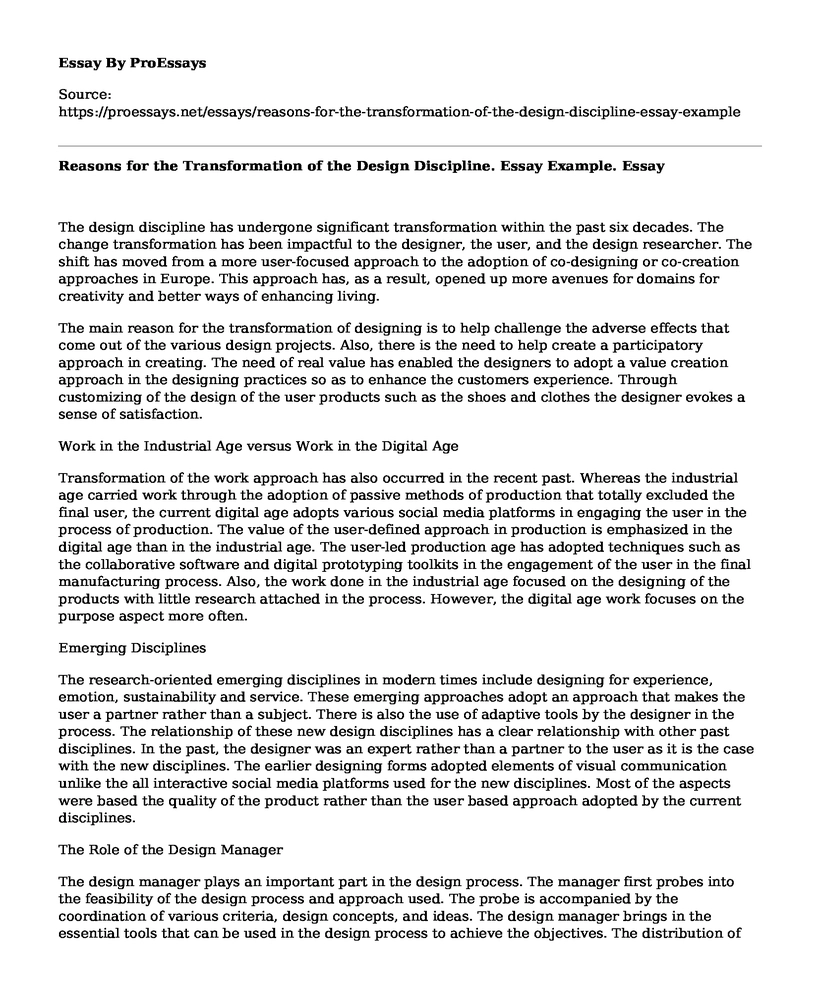The design discipline has undergone significant transformation within the past six decades. The change transformation has been impactful to the designer, the user, and the design researcher. The shift has moved from a more user-focused approach to the adoption of co-designing or co-creation approaches in Europe. This approach has, as a result, opened up more avenues for domains for creativity and better ways of enhancing living.
The main reason for the transformation of designing is to help challenge the adverse effects that come out of the various design projects. Also, there is the need to help create a participatory approach in creating. The need of real value has enabled the designers to adopt a value creation approach in the designing practices so as to enhance the customers experience. Through customizing of the design of the user products such as the shoes and clothes the designer evokes a sense of satisfaction.
Work in the Industrial Age versus Work in the Digital Age
Transformation of the work approach has also occurred in the recent past. Whereas the industrial age carried work through the adoption of passive methods of production that totally excluded the final user, the current digital age adopts various social media platforms in engaging the user in the process of production. The value of the user-defined approach in production is emphasized in the digital age than in the industrial age. The user-led production age has adopted techniques such as the collaborative software and digital prototyping toolkits in the engagement of the user in the final manufacturing process. Also, the work done in the industrial age focused on the designing of the products with little research attached in the process. However, the digital age work focuses on the purpose aspect more often.
Emerging Disciplines
The research-oriented emerging disciplines in modern times include designing for experience, emotion, sustainability and service. These emerging approaches adopt an approach that makes the user a partner rather than a subject. There is also the use of adaptive tools by the designer in the process. The relationship of these new design disciplines has a clear relationship with other past disciplines. In the past, the designer was an expert rather than a partner to the user as it is the case with the new disciplines. The earlier designing forms adopted elements of visual communication unlike the all interactive social media platforms used for the new disciplines. Most of the aspects were based the quality of the product rather than the user based approach adopted by the current disciplines.
The Role of the Design Manager
The design manager plays an important part in the design process. The manager first probes into the feasibility of the design process and approach used. The probe is accompanied by the coordination of various criteria, design concepts, and ideas. The design manager brings in the essential tools that can be used in the design process to achieve the objectives. The distribution of important resources in the designing process and the provision of future insights in the process of designing are some of the roles of the design manager. In the event of a shift such as the content transformation from the industrial age to the adoption of Web 2.0 approaches, the design manager is essential in ensuring the adoption of the new designing approaches.
Cite this page
Reasons for the Transformation of the Design Discipline. Essay Example.. (2021, Apr 05). Retrieved from https://proessays.net/essays/reasons-for-the-transformation-of-the-design-discipline-essay-example
If you are the original author of this essay and no longer wish to have it published on the ProEssays website, please click below to request its removal:
- Artist Waiting for Harry Essay
- Scenarios of Social Media Platforms' Managing Paper Example
- Debussy: Sonata for Cello and Piano Essay
- BBC Documentary Panorama Behind Closed Doors Elderly Care Exposed Reflection Essay
- Disney's Fairytales: Breaking the Spell of Gender Stereotypes - Essay Sample
- Jazz at Lincoln Center Orchestra Lights Up Rose Theatre with Tribute to Miles Davis - Essay Sample
- Free Essay Example on Mass Media: A Comprehensive Introduction to Modern Communication Channels







